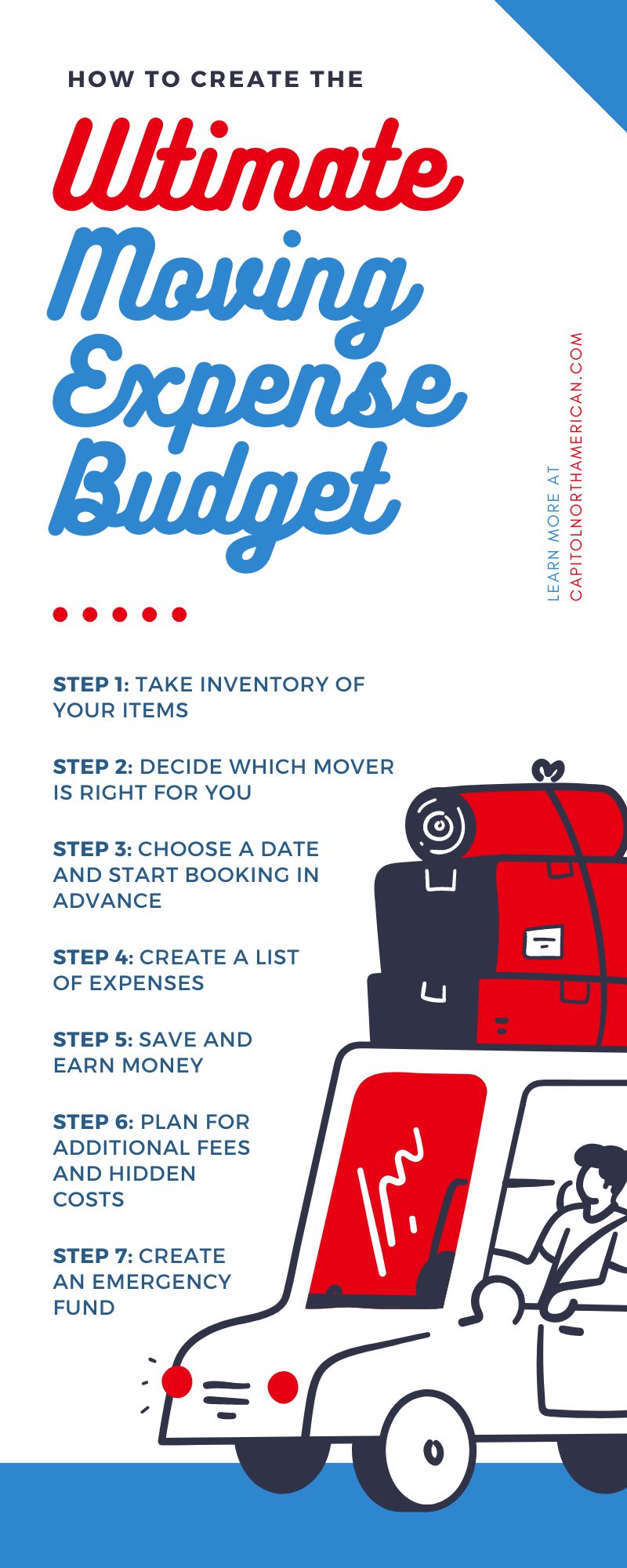
Moving is complicated, and without proper planning, the process can also be quite expensive. It’s difficult to construct an accurate moving budget, especially when moving companies estimate their costs based on weight and moving distance.
Because these two elements are circumstantial, you may find yourself a little lost on where to begin. That’s OK! We can help you figure out how to create the ultimate moving expense budget. Paying attention to detail and being proactive will make a world of difference.
Step 1: Take Inventory of Your Items
Before you start looking into moving companies, you need to know much stuff you plan to move. Make a list of every item that will make the journey to your new home. Start with your larger items first to get a better cost estimate. These items include:
- Living room furniture
- Dining room furniture
- Bedroom furniture
If you have outdoor furniture, include that in your extensive list of items too. For your smaller items, you typically don’t need a precise count. However, doing so will help you narrow down the costs for insurance claims. These smaller items to list include:
- Books
- Clothing
- Kitchen wear
- Electronics
Some of these smaller items will also include things like lamps, vases, house plants, and entertainment items. Your pictures and artwork can also qualify as smaller household items.
Step 2: Decide Which Mover Is Right for You
Once you organize all the items you want to bring into your new home, you can figure out what type of movers you need. Professional movers will need your inventory lists so they can provide you with an estimate or quote. Most companies base the quotes on a range of factors.
Moving Fee
Most companies start off with a base moving fee. This fee is the price customers pay regardless of the number of items they need the movers to transport.
Specialty Items Fee
A specialty items fee applies to things like artwork, safes, musical instruments, pool tables, and other precious valuables. The companies will charge an additional fee because these items are fragile or awkward. They are more difficult to move, so movers must handle them with particular care.
Insurance
Many professional moving companies offer their customers insurance, sometimes referred to as valuation. If the moving process damages any pieces of your property, they will compensate you. Most companies don’t charge for basic coverage, but they will charge extra for options with more protection.
Services
See what services these companies offer. If you want to hire professionals, look for a registration number. The USDOT number indicates they have the proper licensure and qualifies them as a company that can travel out of state. At Capitol North American, we have Nevada long-distance movers that even perform international moves.
Step 3: Choose a Date and Start Booking in Advance
Decide when and where you want to move. The sooner you know when you’re moving, the sooner you can start booking services and making reservations. When you schedule services in advance, you save money because you avoid paying a premium price companies would charge for the short notice.
You need to factor in your lease, sale terms, and work schedule when creating your budget. The time of year you decide to move will affect the costs. If you can, try to be flexible with your schedule.
Lastly, where you choose to move will impact how much the move costs. If you move from a rural area to a big city, the cost of living will be higher than moving from a city. It’s also wise to check if your new location requires a moving permit to park moving trucks.
Step 4: Create a List of Expenses
After you’ve collected all your information and chosen a date to move, you can start to create a preliminary budget. Begin by laying out all your expenses and costs. To stay organized, consider making a spreadsheet so you can see all the figures clearly.
In one column, have the cost category for each item, and in the other column, include either the priced quotes or detailed estimates. Keep this file so that you can clearly view all your expenses during the moving process.
Step 5: Save and Earn Money
Chances are the money you currently have allotted toward the move won’t be enough. You’ll need to find ways to earn and save money so you can afford your move more comfortably. Consider cutting back on some of your extra expenses.
If you eat out too much, try buying groceries and recreating those dishes you would’ve enjoyed at a restaurant. Freeze some of those leftovers and eat them for lunch the next day at work. Dress up your wardrobe in different ways instead of buying new clothes. Test out how creative you are.
If you want to earn some extra income, consider having a yard sale. After you organize and categorize the items you plan to bring with you to your new home, determine which of the items you don’t want you can sell. Instead of giving everything away, benefit from the fact that some of your things still have value. You can use the extra money to help pay for additional protection options.
Step 6: Plan for Additional Fees and Hidden Costs
Whether you’re moving by yourself or hiring professionals, hidden costs may pop up along the way. Try to plan ahead and include them in your budget to avoid any surprises. Ask yourself a few questions as you craft a budget.
- Do you need to professionally clean your old or new home?
- Do you need your movers to help you with the packing and unpacking process?
- Do you have houseplants or pets traveling with you?
- Do you need your movers to set up your furniture?
- Do you need to take additional time off from work?
Step 7: Create an Emergency Fund
Hidden expenses aren’t the only things that pop up during a move. Moving comes with some curveballs, and you need to prepare yourself to catch them. No matter how thoroughly you plan and budget, surprises happen. Create an emergency fund to prepare for the worse.
Have enough money stored away to handle emergencies from car malfunctions to a moving truck delay. The money you collected from the yard sale can go into this emergency fund, which can help take some of the pressure off your savings account.
Capitol North American wants to ensure you create the perfect plan to budget properly for your moving expense. We offer services to accommodate all your needs. Visit our website for more information on how to make your move successful.


